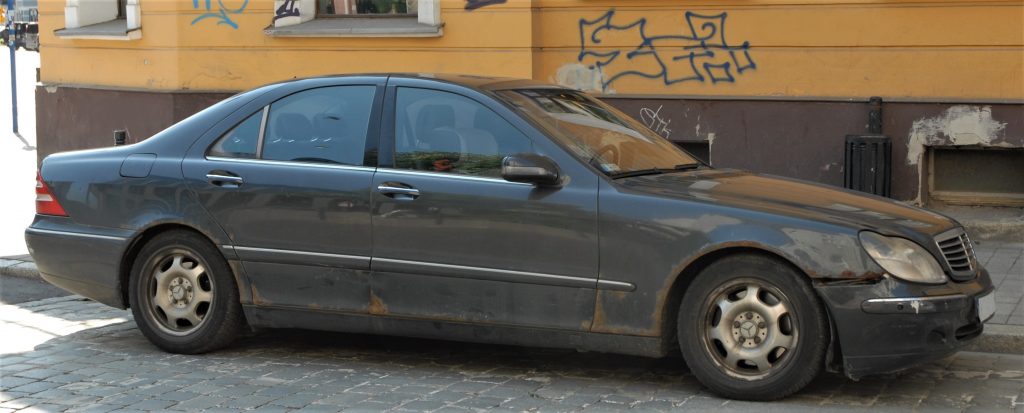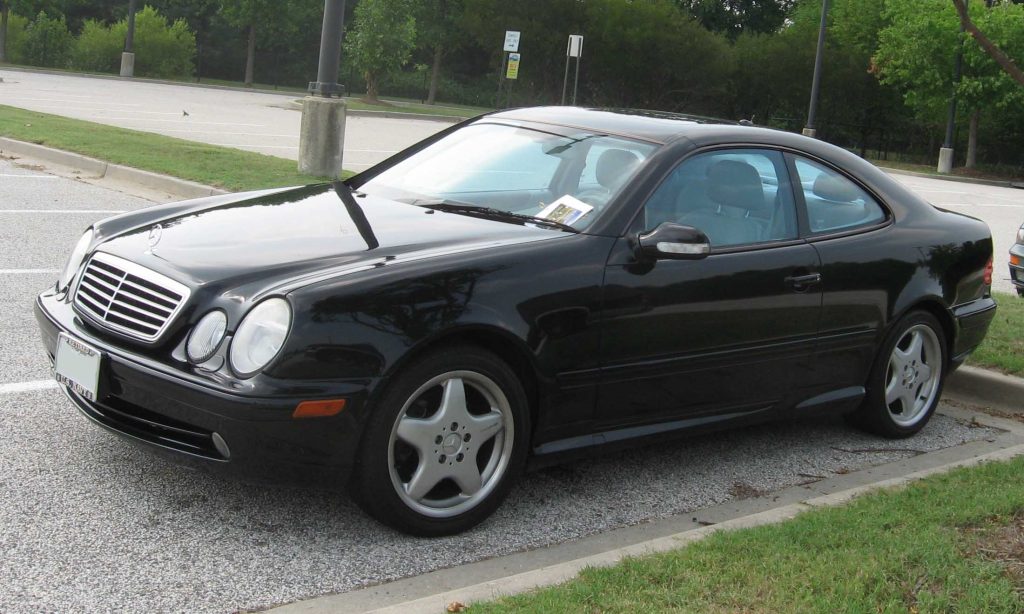Mercedes-Benz CLK-Class (W208: 1997-2003)
Reliability & common problems
This section covers the potential reliability issues that you might have with the Mercedes-Benz W208. Click on the buttons below to read more about the typical problems that fall outside the scope of routine maintenance.
Corrosion (water-based paint)
In my opinion, rust is by far the number one problem with this car and other Mercedes-Benz vehicles produced between 1993 and 2004. In 1993, Mercedes-Benz implemented a more environmentally friendly, water-based paint.
Unfortunately, the new paint offered less protection from rust. With no galvanizing process, and coupled with steel that wasn’t very corrosion resistant, the W210 E-Class can corrode pretty much everywhere. When buying a Mercedes-Benz from that era, inspecting it for rust should be one of your top priorities.
Mercedes-Benz eventually started galvanizing their cars but it wasn’t until around 2004. The production of the W208 CLK-Class stopped in 2002 for the coupe and 2003 for the convertible. Only its successor, the W209 model, received a galvanized body.
Here’s why good corrosion protection is important:

Spring perch failure
There have been cases of front spring perches breaking off the car. The spring perch failures are directly related to poor corrosion protection on these cars and their age. The front suspension spring perches are welded to the inner wing. This area, being so close to the wheels, gets splashed with water (and salt in winter).
The weld is coated at the factory to provide some protection, but over time moisture penetrates the coating and starts corroding the metal.
Corrosion in that area may eventually lead to one of the spring perches breaking off. If it happens, the suspension collapses and the tyre suddenly has the option to meet with the fender. As you can imagine, this can be dangerous if it happens at the wrong time.
You may never see this problem in dry climates with salt-free roads, but otherwise, this is something to consider. I believe it’s more common to see failed spring perches in the W210 E-Class, probably because of the higher weight, but both models have equally bad corrosion protection, in my opinion.
If you are planning to buy the W208 CLK-Class, and you live in a wet or cold climate, I recommend getting the spring perches checked and even reinforced after your purchase.
You won’t be able to check them before buying the car as you would need to peel off the coating to see the welds. Even then, it’s not obvious if the welds are still good. Replacement spring perches are available and can be riveted/welded back to the car if the original ones fail.
Convertible roof
The soft top roof is operated by 7 hydraulic actuators (+1 for the rollbar), powered by a hydraulic pump. Your two biggest concerns are hydraulic system issues (mainly leaks) and weather intrusion (fancy name for a leaking roof).
The typical things to check on a Mercedes-Benz convertible are as follows:
-
Check for any dampness in the footwells and carpets. Also, check in the boot underneath the spare wheel. It’s best to do it after rainfall.
-
Open and close the roof a couple times to make sure it works.
-
Check the condition of the roof fabric.
-
Check the condition of the roof seals. Ideally, they should be lubricated regularly – ask the previous owner about it.
-
Check if the level of hydraulic fluid is correct. If it isn’t, then the car may have been neglected or there is a leak somewhere.
-
Look for hydraulic fluid leaks – in the boot, behind the seats and around the hydraulic rams.
-
Get the car up to 60 mph with the roof closed and listen for excessive wind noise.
-
Listen for rattling noises while driving with the roof closed.
-
Take the car to a high pressure (touchless) car wash and see if any water gets inside the cabin or the boot.
-
Accident-free history is important for a soft top convertible and very important for a hardtop convertible. If the car participated in a large crash, the roof may be out of alignment. It will be more likely to leak if the chassis of the car isn’t “straight” anymore.
The hydraulic rams last only so long before the seals deteriorate and start leaking (15 years reliably at most). The OEM rams are expensive but there are companies that sell reconditioned units. You can also buy just the seals and replace them yourself (advanced DIY).
Along with the hydraulic system, there is plenty of electronics to manage the roof in the Mercedes-Benz W208 CLK-Class. These cars are getting quite old and sometimes the roof can be a bit fussy. The roof seals, unless replaced at some point, might already be tired too so the roof may let some water in when it rains (adjustment and seal lubrication helps).
M111 engine – head gasket failure
The head gasket is the weak point of these engines. Considering head gasket replacement is inevitable at some point, often around 150k miles.
Before the gasket fails completely, these engines often develop an external oil leak from the head gasket at the back of the engine. Make sure to inspect that area when buying one of these cars. Once the head gasket fails and is replaced, the new one should be good for another 100k – 150k miles.
This issue mainly affects the inline-6 engines, like the M103 or M104, because of their long cylinder heads. However, the 4-cylinder M111 engines are also affected, but to a smaller degree.
M111 engine – “Kompressor” lifespan
The “Kompressor” variant is fitted with an Eaton (M62 or M45) supercharger. They are reliable but have a finite lifespan. I estimate that they will need to be rebuilt after around 150,000 miles. The engine and other components under the bonnet will last a lot longer, so it’s very likely that the car will need to have the supercharger rebuilt or replaced at some point during its lifetime.
Summary of problems & additional information
-
Except for the rust, which can be a serious issue, the W208 should be pretty reliable. Just like the older Mercedes-Benz cars, it is well engineered and relatively easy to work on. It is based on the W202 C-Class chassis and shares parts with the W202 and the W210 E-Class models.
-
Unless you can find a rust free example, I would stay away from this model. If you do decide to buy it, be prepared to spend some time and money on dealing with the rust in the long run. That is if you live in a wet or cold climate. If you live in a place like Spain, buying a Mercedes-Benz W208 is not a bad idea at all. Another option is to get the next generation CLK – the W209 model, which from mid-2003 had much better corrosion protection.
-
The V6 M112 (CLK 320) and V8 M113 (CLK 430 & CLK 55 AMG) engines – Mercedes-Benz got both of them right. They are closely related to each other and both are reliable.
-
Watch out for potential head gasket problems in the M111 engines. Also, these engines are supercharged. The superchargers (“Kompressor”) have a finite lifespan and they will need to be rebuilt at some point.
-
All W208 engines are fitted with timing chains, which normally don’t have a specified replacement interval. The timing chains in the W208 are generally reliable, but they will not last forever. Click here to learn more about timing chains and belts.
-
Diesel engines were not available in the W208 chassis but you can get one in the newer W209 CLK-Class model.
-
[CONVERTIBLE]: The soft top roof on the CLK is reliable, but it is still relatively complex. Some small things may at some point require fixing or adjusting. If you can’t diagnose or repair these little things yourself, trying to get the roof sorted out at a car repair shop can get expensive. The W208 CLK is already quite old, so the hydraulic seals are probably on their way out if they haven’t been replaced yet. Look out for any hydraulic leaks.
Mercedes-Benz W208 specifications
This section contains Mercedes-Benz W208 specifications. You will also find technical information regarding the engines used in these cars. Press the buttons below to display the specs and engine technical details.
Petrol engines – specs & performance figures
| Model | Engine | Displacement | Power | Torque | Comments |
|---|---|---|---|---|---|
| CLK 200 | M111 | 1998 cm³ / 121.9 cu in | 136 PS / 100 kW | 190 Nm / 140 lbf⋅ft | Until 2000 |
| CLK 200 Kompressor | M111 | 1998 cm³ / 121.9 cu in | 163 PS / 120 kW | 230 Nm / 170 lbf⋅ft | From 2000 |
| CLK 200 Kompressor | M111 | 1998 cm³ / 121.9 cu in | 192 PS / 141 kW | 270 Nm / 199 lbf⋅ft | Sold in Italy, Portugal, Greece and Turkey until 1999 |
| CLK 230 Kompressor | M111 | 2295 cm³ / 140.0 cu in | 193 PS / 142 kW | 280 Nm / 206 lbf⋅ft | Until 2000 |
| CLK 230 Kompressor | M111 | 2295 cm³ / 140.0 cu in | 197 PS / 145 kW | 280 Nm / 206 lbf⋅ft | From 2000 |
| CLK 320 | M112 | 3199 cm³ / 195.2 cu in | 218 PS / 160 kW | 310 Nm / 229 lbf⋅ft | All years |
| CLK 430 | M113 | 4266 cm³ / 260.3 cu in | 279 PS / 205 kW | 400 Nm / 295 lbf⋅ft | From 1998 |
| CLK 55 AMG | M113 | 5439 cm³ / 331.9 cu in | 347 PS / 255 kW | 510 Nm / 376 lbf⋅ft | From 1999 |
Petrol engines – technical details
| Engine | Engine config. | Forced induction | Valve timing | Fuel delivery | DMF | Inlet flaps |
|---|---|---|---|---|---|---|
| M111 | Inline-4, 16 valves | Naturally aspirated or supercharged | Timing chain, DOHC, VVT | Port injection (EFI) | Yes | No |
| M112 | V6, 18 valves | No | Timing chain, SOHC | Port injection (EFI) | Yes | No |
| M113 | V8, 24 valves | No | Timing chain, SOHC | Port injection (EFI) | Auto. trans. only | No |
| Legend: | SOHC - Single Overhead Camshaft DOHC - Double Overhead Camshaft VVT - Variable Valve Timing EFI - Electronic Fuel Injection DMF - Dual-mass Flywheel (does not apply to auto. transmissions with torque converters) |
|||||
Mercedes-Benz W208 wheel sizes
Press the button below to see the original equipment manufactuer (OEM) rim & tyres sizes for the Mercedes-Benz W208. These are the original wheel sizes that were fitted by the manufacturer.
| Tyres | Rims | Centre Bore | Bolt Pattern | Comments |
|---|---|---|---|---|
| 195/65 R15 | 6.5Jx15 ET37 | 66.6mm | 5x112 | |
| 205/60 R15 | 7Jx15 ET37 | 66.6mm | 5x112 | |
| 205/55 R16 | 7Jx16 ET37 | 66.6mm | 5x112 | |
| 205/55 R16 front & 225/50 R16 rear | 7Jx16 ET37 front & 8Jx16 ET36 rear | 66.6mm | 5x112 | Staggered setup |
| 225/45 R17 | 7.5Jx17 ET37 | 66.6mm | 5x112 | |
| 225/45 R17 front & 245/40 R17 rear | 7.5Jx17 ET37 front & 8.5Jx17 ET30 rear | 66.6mm | 5x112 | CLK 55 AMG - front ET37 & rear ET34, staggered setup |
Share this page:


